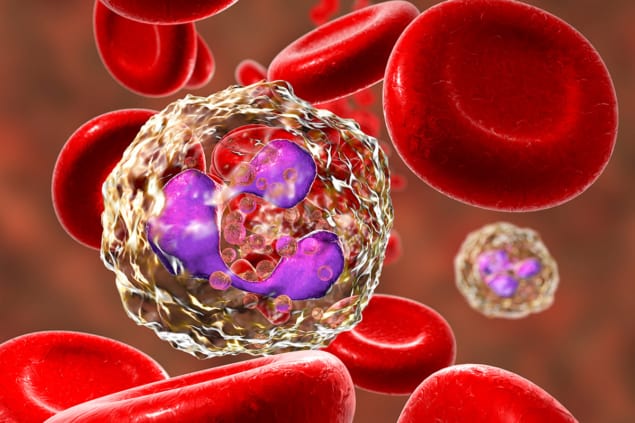Laser manipulation turns white blood cells into medicinal microrobots
25 Aug 2022
Creating microrobots: Neutrophils, white blood cells that play a key role in the body’s immune system, can be remotely activated and navigated by light for targeted delivery of nanomedicine. (Courtesy: iStock/Dr_Microbe)
White blood cells can be harnessed as natural, biocompatible microrobots through the use of lasers, researchers from China have reported. The finding, which the team demonstrated in living zebrafish, could pave the way towards a new method of targeted drug delivery for precision treatment of diseases.
Medical microrobots have attracted considerable attention for their potential to deliver drugs to particular sites in the body and to help clear pathogens from the circulatory system.
In most medical microrobot concepts, the tiny tools are fabricated outside of the body and then either injected into the patient or packaged up in capsules and then swallowed. Trials in small animals, however, have revealed a problem – namely that these foreign objects have a tendency to trigger an immune response in their host body, with the result that the microrobots end up being removed from the body before they can fulfil their intended purpose.
To get around this, an alternative approach lies in taking cells that are already present in the body – and are therefore not at risk of setting off an immune response – and press ganging them into service as natural microrobots.
In their latest study, bioengineers Xianchuang Zheng and Baojun Li of China’s Jinan University and their colleagues have been experimenting with the co-option of neutrophils – a type of white blood cell that plays a key role in the body’s immune system – into microrobots. These neutrophils are ideal candidates for use as microrobots, as they already naturally capture both nanoparticles and dead red blood cells, and are capable of migrating out of blood vessels into the surrounding tissue – two of the key functions needed for targeted drug delivery.
The team explains: “As the first line of host defence against invading pathogens, neutrophils have an inherent phagocytosis capability for the elimination of foreign agents and target loading upon activation, as well as the ability to transmigrate across blood vessels to the infected tissue, making them natural candidates to execute various medical tasks in vivo.”
Previous research has shown that it is possible to use laser light to move neutrophils around as desired in vitro. However, information was lacking as to whether the same approach would also work within living organisms.
In a series of experiments, the researchers used focused laser beams as optical tweezers to manipulate and manoeuvre neutrophils within the tails of living zebrafish. The team succeeded in driving the white blood cells at velocities of up to 1.3 µm/s, around three times faster than a neutrophil naturally moves.
Zheng, Li and colleagues also demonstrated the ability to accurately and precisely control the functions that neutrophils normally perform as part of the zebrafish immune system. For example, one operation saw the team guide a “neutrobot” out of a blood vessel into the surrounding tissue, while another saw one of the white blood cells used to pick up and transport a plastic nanoparticle – a capability that has the potential to be exploited for targeted delivery of nanomedicines within the body.READ MORE

Furthermore, the team also found that pushing a neutrobot towards the debris from a dead red blood cell prompted it to engulf the pieces. What came as a surprise, however, is that as they did this, the researchers also witnessed another neutrophil, this one not under their control, also try to naturally remove the cellular debris.
The researchers conclude: “This concept of a native neutrophil microcraft, coupled with the intelligent control of multiplexed assignment execution, could hold great promise for the active execution of complex medical tasks in vivo, with great potential utility in the treatment of inflammatory diseases.”
The study is described in ACS Central Science.
Ian Randall is a science writer based in the UK.
from physicsworld.com 28/8/2022

Δεν υπάρχουν σχόλια:
Δημοσίευση σχολίου